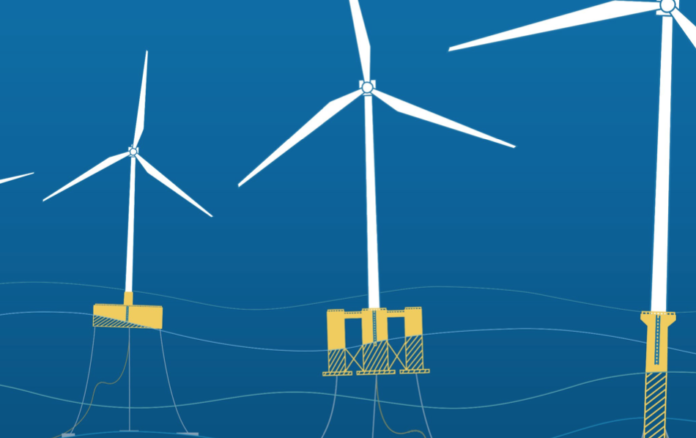The Carbon Trust has released the latest summary findings from the Floating Wind Joint Industry Project (JIP).
The Floating Wind Joint Industry Project – Phase II summary report outlines floating wind technology challenges prioritized by developers to accelerate the commercialization of floating wind. The findings summarize the work across four main themes: turbine requirements and foundations scaling, heavy-lift offshore operations, dynamic export cables, and monitoring and inspection.
The report also includes new market projections from the Carbon Trust, forecasting 70 GW of floating wind capacity installed by 2040.
Floating wind is an emerging but growing renewable energy sector. The technology enables offshore wind turbine installation in deeper waters not suitable for bottom-fixed turbines, unlocking new areas for renewable energy generation. Pilot and demonstration projects have shown the potential for similar – or even higher – yields from floating turbines compared to bottom-fixed projects, as they can be situated in locations with a higher wind resource.
“I am sure that floating offshore wind will play a crucial role in our future renewables generation and in helping us achieve a green recovery following the COVID-19 pandemic,” says Paul Wheelhouse, Scotland’s Energy Minister.
“The Scottish government is committed to supporting research and development that will help address challenges associated with helping achieve commercial-scale deployment of floating offshore wind – and are supporting innovation in the sector through our funding of the JIP,” he adds.
A study on turbine requirements and foundations scaling, delivered by Ramboll, looked at the potential impacts of installing larger, next-generation turbines on floating substructures. Aside from turbine towers and controllers, it found that only minor modifications would likely be needed for future turbines and that the required relative primary steel, secondary steel and mooring mass decreases for larger turbines.
A heavy-lift offshore operations study undertaken by Seaway 7 investigated the challenges associated with floating heavy lift offshore construction and maintenance operations for turbines up to 20 MW. It found that the limited availability and high cost of suitable floating heavy lift vessels in the market at present is a barrier to cost-effectively undertaking operations offshore. There is a need for vessels capable of undertaking the required heavy lift operations or alternative lifting solutions, such as climbing crane technology.
BPP Cable Solutions investigated the challenges and assisted in the development of high voltage dynamic export cables required to transport power from floating offshore wind farms. Previous JIP studies have highlighted a lack of suitable dynamic cables currently available on the market. A competition was launched to support cable manufacturers develop and test suitable designs. Five cable manufacturers are currently being supported by the JIP to make these available as products for future projects.
A study focused on monitoring and inspection undertaken by Oceaneering, looked at the techniques for assessing the integrity of floating wind farms. It concluded that improvement is needed in both the collection of data and its usage to inform and manage asset integrity for floating wind farms, and in particular for subsea assets.
These studies follow Phase I of the JIP’s work which started with a focus on electrical systems, mooring systems and logistics for construction and operation for floating wind. Findings were published from these projects in 2018.
Photo: To read the Floating Wind JIP’s full Phase II summary report, click here




